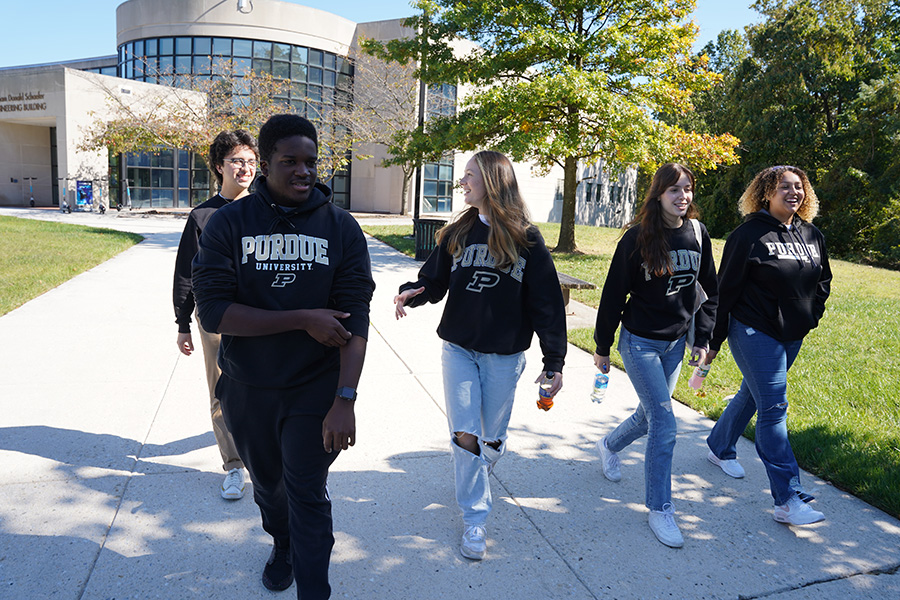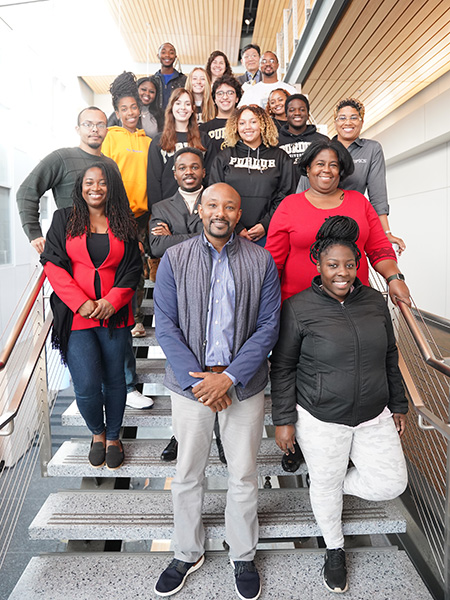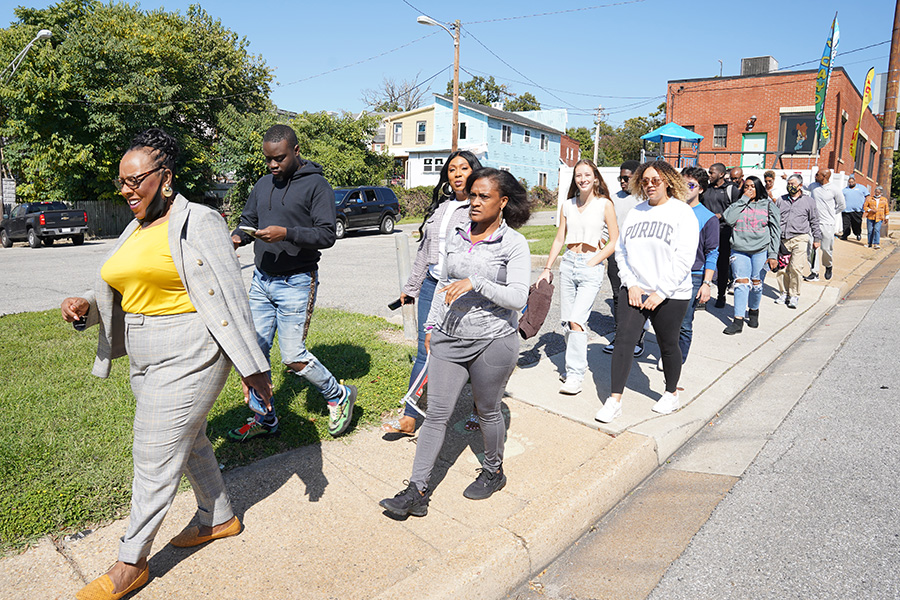Purdue helps bring pilot EPICS program to Morgan State University

When First-Year Engineering (FYE) students Aaliyah Crawford and David Amieva flew to Baltimore to visit their design project collaborators and community partner, the project they have been working on diligently since September finally felt real.
Crawford and Amieva are design leads for Purdue’s Environmental Justice and Access Education (EJAE) class, part of Purdue’s Engineering Projects In Community Service (EPICS) program. Together with three other FYE students and EJAE advisor and EPICS K-12 Coordinator Charese Williams, Crawford and Amieva traveled to Morgan State University, a Historically Black University in northeast Baltimore. They are collaborating with Morgan State civil engineering students on an ambitious multi-year engineering-based design project, the Better Waverly project.
“We had been in the classroom up to this point, so everything was on paper. It didn't really set in that it was real until we were actually there walking, seeing where we are going to be building and meeting the people of the community. It's really exciting,” Crawford said.
The early-October trip marked the beginning of a long-awaited partnership between Purdue’s EPICS program and Morgan State. Through the Better Waverly project, the two universities hope to improve access to essential community resources in the Better Waverly neighborhood and serve as a pilot project for Morgan State’s own EPICS program.
An ambitious and strategic partnership
Purdue founded EPICS, a service-learning design program, in 1995. In the program, student teams are partnered with local and global community organizations and design projects that address human, community and environmental needs. Over the last two decades, the program has expanded to K-12 institutions and other universities. But the Better Waverly project is different from previous EPICS programs, says Bill Oakes, director of the EPICS program at Purdue.

“This is the first time we've used EPICS as a linchpin in a strategic new relationship with a university,” Oakes said.
The two universities had been talking about partnership opportunities for years, and this is an exciting endeavor for the schools, he said.
“For me, this is a dream come true. Honestly, this type of relationship, with an institution that has the kind of modern and historical impact as Morgan State and working on something as ambitious as this is, is exciting,” Oakes said.
James Hunter is an associate professor in the department of civil engineering at Morgan State and part of the effort to bring EPICS to the school. Hunter is a Purdue alumnus and has personal experience with EPICS. He earned his master’s of civil engineering from Purdue in 2002 and his doctorate in civil engineering in 2006. His experience as a teaching assistant in EPICS during his master’s program is one reason he pushed to bring the opportunity to his civil engineering juniors and seniors this year.
“What I love about EPICS, and why I believe it’s such a great match for Morgan State, is when you get a core group of students who are really passionate about these projects, the outcomes are just tremendous,” he said.
Students excited to bring real impact to Better Waverly
The Better Waverly project is a multi-year project for community partner Garden of Prayer Christian Church, a charming brick building two miles from Morgan State’s campus proper. With EPICS and Morgan State support, the church plans to acquire land to build a community center, medical center, affordable housing and, eventually, another sanctuary with hopes to offer services and resources the community doesn’t currently have.
Crawford, Amieva and the rest of the EJAE team conducted a feasibility study and collected demographic information. Phase one, they decided, is focused on building a community center. In their research, they’ve sought answers to questions such as, what’s the process of acquiring land, demolition and reconstructing different types of buildings?
“A lot of their information up to this point has been understanding that process and sharing it with the Morgan students,” said Williams, a Morgan State alumna of electrical engineering and member of Garden of Prayer.
The three-day trip was the first time the students met their Morgan State collaborators and community partner in person. Crawford said that visiting the campus and meeting their community partner brought a new perspective to the project.
“I think the way we would think about the project here would be a lot different than having a school that's actually in the community, how they would want to approach it and how they think they could best help their community,” said Crawford. “I think this partnership is particularly important because the Morgan State students can actually see what needs to be done.”
Discussing EPICS with Morgan State students and faculty left Amieva proud to be part of the program.
“The way Dr. Hunter is pushing for EPICS to be integrated into Morgan State's curriculum really showed its prestige. He held it to a very high standard,” he said. “It just made me feel like I am getting a really good start in terms of real-world experience in an engineering context.”
The project is a mutual learning opportunity
Morgan State hopes to learn from Purdue’s 27-year experience how EPICS could work at their university. Hunter explained that service-learning initiatives in the local community, like the Morgan Community Mile and individual senior capstone projects, have been a focus for the university for a long time. But this partnership offers an interdisciplinary and stakeholder-driven approach to education that provides unparalleled real-world job experience.
“As Morgan is doing more within our own community and expanding our footprint across the city and state, this seems like a really good way to have a very interdisciplinary approach that connects with what our students are learning in the classroom,” Hunter said.
Issues like the urban heat island effect and flooding disproportionately affect communities like Better Waverly that have been impacted by historic redlining and climate change. Hunter said his students look forward to honing in on social and economic divides in the city and trying to improve upon them, particularly environmental justice issues in a community like the ones many of his students grew up in.
“Our students really want to work on projects that have an impact, particularly from the communities that they come from. That’s why the EPICS program is a really good fit,” he said.
The two universities are in the very early stages of the pilot program but are excited about the numerous benefits the experience will bring. Right now, Hunter’s graduate students act as consultants to the FYE students and as ‘boots on the ground’ for the project. Next semester, he hopes to formalize a class around the program and offer it as a senior capstone project.
“They're going to be going into neighborhoods, working with stakeholders and working on projects that have real impact and real outcomes,” he said. “The students are going to gain that kind of professional development work and technical expertise.”
Amieva said he’s looking forward to working with Morgan’s graduate students who can skillfully apply the EJAE team’s ideas and bring important insight into the project area.
“They have personal ties with the area and know what is going to work and what isn't. We’ll bounce ideas off each other, which I'm really looking forward to,” Amieva said.
The experiences opened their eyes to new perspectives, too.
It was Amieva's first time visiting a Black church.
“It was a pretty cool experience,” he said.
Williams explained that building relationships with the community was another important goal of the trip.
“One of the key things with EPICS is that we want our students to be empathetic to the situation to the community partner and really be engaged,” Williams said. “And up to this point, they have truly made it their own.”
Small steps toward a successful partnership
During the trip, both universities talked about when and how they’ll communicate and what the partnership will look like in the future, though Williams said they are taking baby steps. EJAE students plan to host their first formal planning meeting with Morgan State students soon to discuss plans for the community center. Advisors look on proudly.
“I think our job is to get the students together and then kind of let them go,” said Hunter. “We're there to guide, but they are very much thrown into a stakeholder-driven environment.… Now, they're getting a lot of good practice. I'm excited about this opportunity and getting our students involved in this program.”
The Better Waverly project is not the first partnership between the two universities. In 2020, the universities came together to offer the “3+2” program. After three years at Morgan State, civil engineering or engineering physics students complete their final two years at Purdue, earning a degree in aeronautical and astronautical engineering. By the end of the program, students will have earned degrees from both universities.
Hunter said that both universities are actively thinking about the future of students in STEM, and the Better Waverly project is another deliberate strategy to bring high-quality programming to students. Next summer, the American Society of Engineering Education (ASEE) national conference is in Baltimore. Hunter said they hope to offer an EPICS workshop at Morgan State around the same time and invite other universities to learn about the program.
“We're thinking about the pipeline for this next generation of students who need to go into STEM,” he said, “That pipeline could lead to Morgan State, Purdue or both. I think that's why this overall partnership and collaboration has such great potential.”

